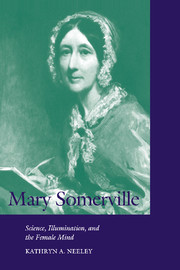Book contents
- Frontmatter
- Contents
- Author's Preface
- Key to Parenthetical References to the Works of Mary Somerville
- Prologue: Perceiving What Others Do Not Perceive: The “Peculiar Illumination” of the Female Mind
- 1 Head among the Stars, Feet Firm upon the Earth: The Problem of Categorizing Mary Somerville
- 2 Creating a Room of Her Own in the World of Science: How Mary Fairfax Became the Famous Mrs. Somerville
- 3 Science as Exact Calculation and Elevated Meditation: Mechanism of the Heavens (1831), “Preliminary Dissertation” (1832), and On the Connexion of the Physical Sciences (1834)
- 4 The Earth, the Sea, the Air, and Their Inhabitants: Physical Geography (1848) and On Molecular and Microscopic Science (1869)
- 5 Mary Somerville on Mary Somerville: Personal Recollections (1873)
- 6 Memory and Mary Somerville: In the Public Eye and Historical Memory
- Epilogue: Science, Voice, and Vision
- Selected Bibliography
- Index
1 - Head among the Stars, Feet Firm upon the Earth: The Problem of Categorizing Mary Somerville
Published online by Cambridge University Press: 30 March 2010
- Frontmatter
- Contents
- Author's Preface
- Key to Parenthetical References to the Works of Mary Somerville
- Prologue: Perceiving What Others Do Not Perceive: The “Peculiar Illumination” of the Female Mind
- 1 Head among the Stars, Feet Firm upon the Earth: The Problem of Categorizing Mary Somerville
- 2 Creating a Room of Her Own in the World of Science: How Mary Fairfax Became the Famous Mrs. Somerville
- 3 Science as Exact Calculation and Elevated Meditation: Mechanism of the Heavens (1831), “Preliminary Dissertation” (1832), and On the Connexion of the Physical Sciences (1834)
- 4 The Earth, the Sea, the Air, and Their Inhabitants: Physical Geography (1848) and On Molecular and Microscopic Science (1869)
- 5 Mary Somerville on Mary Somerville: Personal Recollections (1873)
- 6 Memory and Mary Somerville: In the Public Eye and Historical Memory
- Epilogue: Science, Voice, and Vision
- Selected Bibliography
- Index
Summary
Mrs. Somerville is the lady who, Laplace says, is the only woman who understands his works. She draws beautifully, and while her head is up among the stars, her feet are firm upon the earth.
–Maria Edgeworth to Miss Ruxton, January 17, 1822The innovative is, by definition, hard to categorize.
–Clifford Geertz, “Blurred Genres: The Reconfiguration of Social Thought”Mary Somerville was an eminent scientist. She achieved an international reputation that established her as both the leading woman of science in Great Britain during the nineteenth century and as one of that century's most celebrated intellectual women. (Patterson 1983) Somerville's greatest scholarly strength was in mathematics, which she mastered at a very high level, but her expertise extended throughout the established and emerging physical and life sciences. She was the first woman to publish experimental results in the Philosophical Transactions of the Royal Society as well as the first – and only – woman to have her bust placed in the great hall of the Royal Society. Hers was the first name on John Stuart Mill's petition to obtain the vote for women in Great Britain. (PR 345) When the founders of Oxford University's first nondenominational women's college sought a name to exemplify ideals of high intellectual achievement for women, “Somerville” seemed an obvious choice. (Adams 1996)
In a letter written in 1829, David Brewster pronounced her “certainly the most extraordinary woman in Europe – a Mathematician of the very first rank.”
- Type
- Chapter
- Information
- Mary SomervilleScience, Illumination, and the Female Mind, pp. 11 - 44Publisher: Cambridge University PressPrint publication year: 2001

